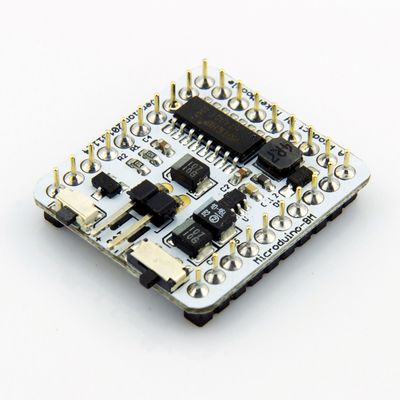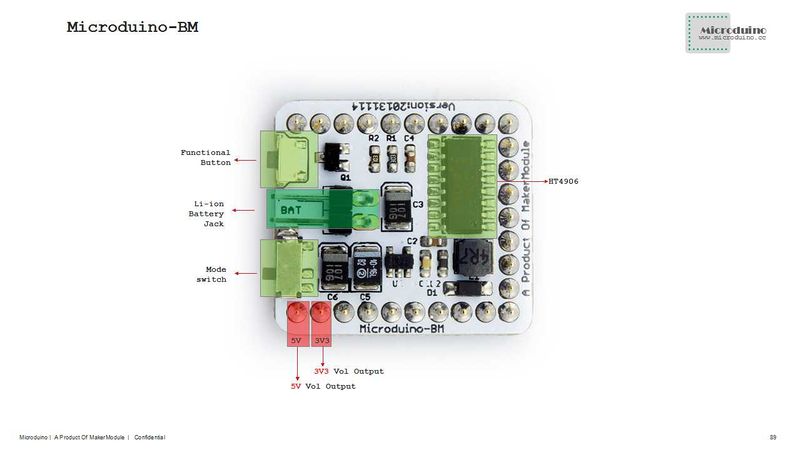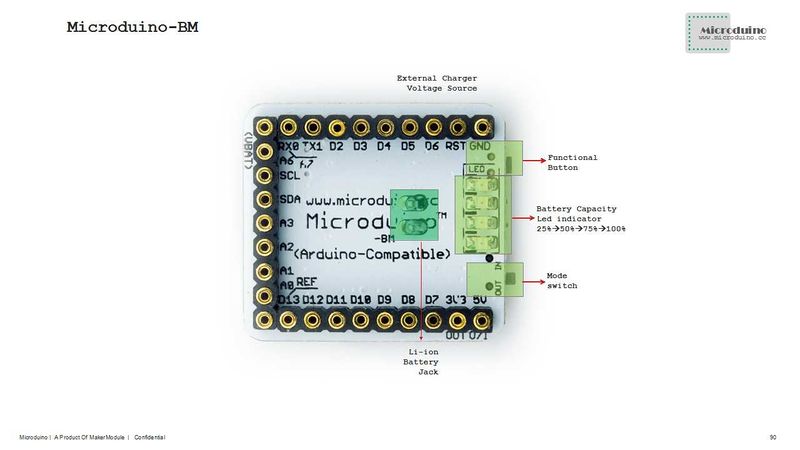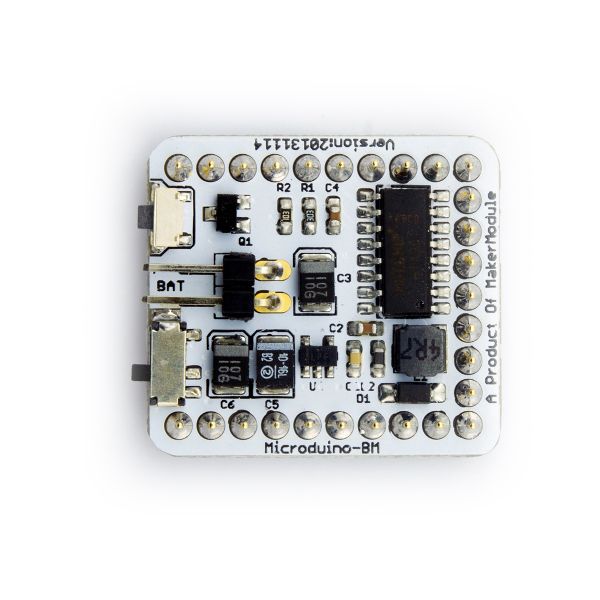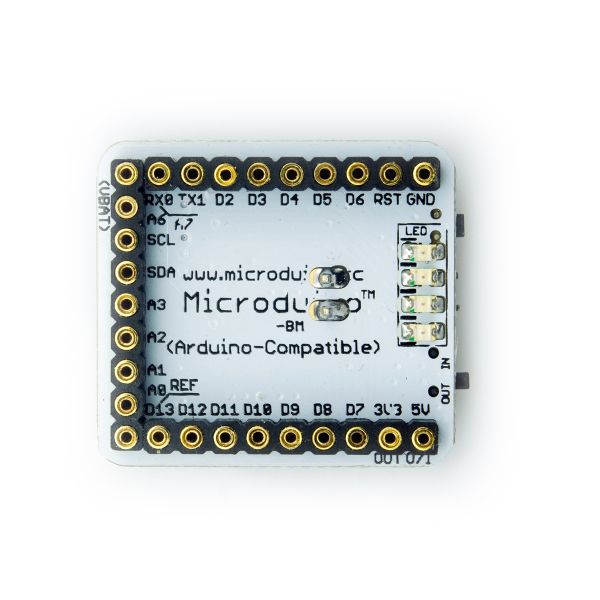Difference between revisions of "Microduino-BM"
(→History) |
|||
| Line 17: | Line 17: | ||
==Features== | ==Features== | ||
* Integrated functions that charge/discharge management, power detection, 5v output, 3.3v LDO; | * Integrated functions that charge/discharge management, power detection, 5v output, 3.3v LDO; | ||
| − | * | + | * Toggle switch controls the charging and discharging, reboot and sleep mode; |
* Small, cheap, stackable, opened platform; | * Small, cheap, stackable, opened platform; | ||
| − | * Define unified interface Microduino specification and contain rich peripheral modules. | + | * Define unified interface Microduino specification and contain rich peripheral modules. Set up the quick connection with other Microduino modules and sensors easily and flexibly. |
* 2.54 pitch row female connector for easy integration into breadboard. | * 2.54 pitch row female connector for easy integration into breadboard. | ||
| Line 27: | Line 27: | ||
==Specifications== | ==Specifications== | ||
===Interfaces=== | ===Interfaces=== | ||
| − | * A | + | * A pushbutton switch |
* A two toggle switchs | * A two toggle switchs | ||
* One pair of 2.54 battery interface ("+" for positive, "-" for negative) | * One pair of 2.54 battery interface ("+" for positive, "-" for negative) | ||
| Line 39: | Line 39: | ||
===Charging=== | ===Charging=== | ||
| − | * Firstly connect external 5V power , and then set the | + | * Firstly connect the external 5V power , and then set the pushbutton switch to "IN" position, the module goes into the charging state, then four LED lights do Surge charging indication (detailed display mode, please refer to HT4901 document), the maximum charging current is 500mA. Finished charging,turn the pushbutton switch to "OUT", and unplug the external 5V charging power. |
* Note: | * Note: | ||
| − | * Always follow the charging process: make sure switch to OUT, plug in the battery, connect external 5V power, switch to IN, start charging, charging completed, switch to OUT, unplug the external 5V Charge power. | + | * Always follow the charging process: make sure switch to "OUT", plug in the battery, connect external 5V power, switch to "IN", start charging, After charging completed, switch back to "OUT" , unplug the external 5V Charge power. |
* Recommended charging power supply: Voltage 5v, current 600ma above; | * Recommended charging power supply: Voltage 5v, current 600ma above; | ||
* Don't add pressure drop elements (such as diodes) in the charging circuit, which impacts the charging current because of lower charging voltage. | * Don't add pressure drop elements (such as diodes) in the charging circuit, which impacts the charging current because of lower charging voltage. | ||
| Line 48: | Line 48: | ||
| | | | ||
===Discharge=== | ===Discharge=== | ||
| − | * Make sure the switch is in the "OUT" firstly. After | + | * Make sure the switch is in the "OUT" firstly. After connect to the battery, the module is in the standby mode, then short press button switch (timer> 50mS), the module will be wake up from standby mode. Voltage output will start at this time, and open UPIN27's GND circuit: Interface 5V outputs 5V voltage, maximum current is 500mA; while 3.3V interface outputs 3.3V voltage, maximum current is 250mA. |
* When the battery voltage under-voltage (3.3V) or enter limiting / boost output short circuit protection, enter standby mode. | * When the battery voltage under-voltage (3.3V) or enter limiting / boost output short circuit protection, enter standby mode. | ||
* Note: | * Note: | ||
Revision as of 02:05, 24 January 2014
|
Microduino-BM is a discharge module which combines a single-cell Li-ion battery charge management, power detection and LED indication. The output voltage is 5V, and LDO is 3.3V output. Provides the outstanding battery management for the Microduino-Core module.
| |||||||||||||||||||||||||||||||||||||||||||||||||||||||
ContentsFeatures
| |||||||||||||||||||||||||||||||||||||||||||||||||||||||
SpecificationsInterfaces
| |||||||||||||||||||||||||||||||||||||||||||||||||||||||
Charging
| |||||||||||||||||||||||||||||||||||||||||||||||||||||||
Discharge
| |||||||||||||||||||||||||||||||||||||||||||||||||||||||
Power detection
| |||||||||||||||||||||||||||||||||||||||||||||||||||||||
Standby
| |||||||||||||||||||||||||||||||||||||||||||||||||||||||
Documents
| |||||||||||||||||||||||||||||||||||||||||||||||||||||||
Development
| |||||||||||||||||||||||||||||||||||||||||||||||||||||||
ApplicationsWhen viewing the board with the battery connector and switches closest to you, with the component side up, the battery connector positive (+) pin is on the left and the ground (-) pin is on the right. The pushbutton switch is on the left and the mode switch (IN = Charge, lever to the left; OUT = Discharge, lever to the right) is on the right. After connecting the battery you must momentarily push the pushbutton switch to start the converter. You can stop the converter/turn off the power by unplugging the battery or by pressing and holding the pushbutton for a few seconds. To use the battery to generate +5 VDC and +3.3 VDC, set the mode switch (to the right of the battery connector when viewed as described above) to OUT (switch lever away from the battery connector). The IN position is used for charging the battery from an external 5VDC, >=600 mA source. The charging current is 500 mA, so I recommend a battery with at least 500 mAH of capacity to avoid charging at a rate >1C. A rough English translation of the charging process is as follows:
The LED indications seem to be as follows, based on how Google Translate translates the Chinese datasheet for the HOTCHIP HT4901 at http://www.hotchip.com.cn/DownFiles/20131126090806453.pdf Discharge Mode
Charge Mode
Be prepared to terminate the charging process immediately when all four LEDs are on and steady. Overcharging lithium-type batteries may result in a nasty fire. I don't know how good the HT4901 is at detecting that the charging process is complete and shutting off the charging current to the battery. Hope I correctly translated this information. /Chip
| |||||||||||||||||||||||||||||||||||||||||||||||||||||||
Pictures
| |||||||||||||||||||||||||||||||||||||||||||||||||||||||
HistoryNovember 14, 2013 new release, major improvements:
|
